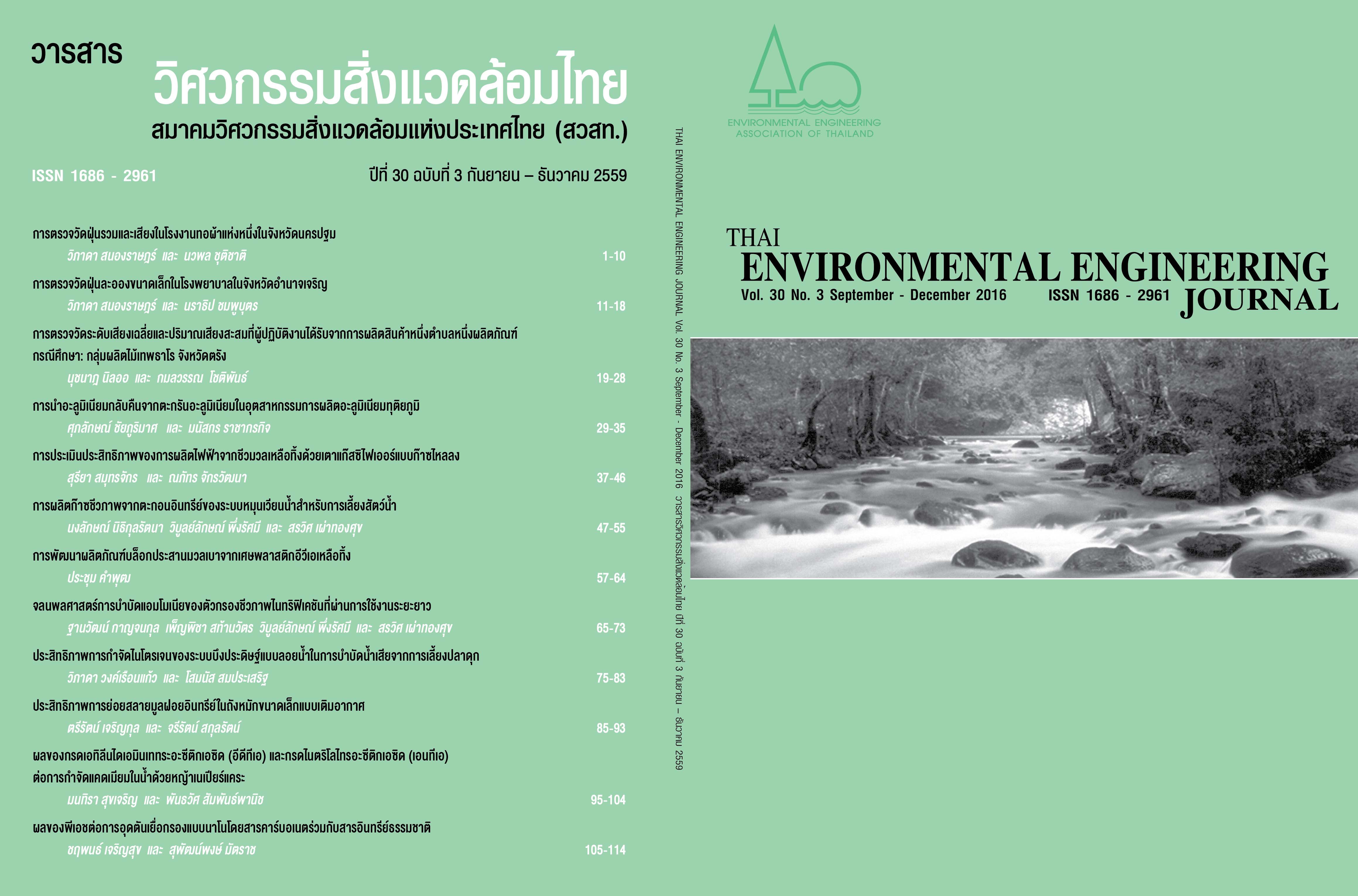Nitrogen Removal Efficiency of Floating Constructed Wetland System in Treating Catfish Farming Wastewater
Main Article Content
Abstract
The objective of this study was to compare two type of plants to treat nitrogen in floating constructed wetland system. Laboratory scale models with the capacity of 106 liters planted with Cyperus spp. and Neomarica spp. three tanks each. The 33x33x5 cm. Styrofoam with nine 6.5 cm holes was used as plant supporter. The 14 mg TKN/L of catfish farming wastewater was batched feeding to the models with 7 days of hydraulic retention time. The study revealed that the model planted with Cyperus spp. had the highest nitrogen removal efficiencies comparing with the models with Neomarica spp. and the control systems. The model planted with Cyperus spp. had a TKN removal efficiency of 77% and left only 3 mg/L in an average of TKN in the effluent. In addition, ammonia removal efficiency was also high, 87%, with 0.7 mg/L of ammonia in the effluent. The Cyperus spp. grow well in the catfish farming wastewater with had high both organic and nitrogen loading. Cyperus spp. grew up 42 cm. of above ground part and increased 56 cm. of root part. Plant density increased from 2 shoots/m2 to 25 shoots/m2 with 1 kg/(m2-d) of biomass increasing. On the other hand, Neomarica spp. grew up 39 cm. of above ground part and 9.56 cm. of root part with only 1 kg/(m2-d) of biomass increasing.
Article Details
References
[2] Keizer-Vlek, H.E., Verdonschot, P.F.M., Verdonschot, R.C.M., Dekkers, The Contribution of Plant uptake to nutrient Removal by Floating Treatment Wetlands. Ecol. Eng. 2014, 73, 684-690.
[3] Kantawanichkul, S. 2003. Wastewater Treatment Performances of Horizontal and Vertical Subsurface Flow Constructed Wetland Systems in Tropical Climate. Faculty of Engineering, Chiang Mai University. (in Thai)
[4] Njau, K. N. and H. Mlay. 2003. Wastewater Treatment and Other Research Initiatives with Vetiver Grass, pp. 231-240. In The Third International Conference on Vetiver and Exhibition – Vetiver and water. Guangdong Academy of Agricultural Sciences, South China Institute of Botany, Chinese Academy Sciences, South China Agricultural University, Guangdong Association of Grass Industry and Environment, Guangzhou.
[5] Pollution Control Department. (2016, April 11). Standard Methods for the Examination of Water and Wastewater. Review from http://www.pcd.go.th/info_serv/reg_std_water04.html#s13
[6] Vymazal, J. 1995. Algae and Element Cycling in Wetlands. CRC press/Lewis Publishers, Florida. R.
[7] Bunprom, P. 2009. Using Vetiver for Dairy Wastewater Treatment at Kasetsart University. Thesis, Kasetsart University. (in Thai)
[8] Somprasert, S., Junge, R. and Kantawanichkul, S. 2007. Effect of Plant Harvesting on Nitrogen Removal in Constructed Wetland System. Proceeding of ICEE 2007, Phuket Thailand: p.026-80. (in Thai)
[9] Cooper, P.E. and Boon, A.G. 1987. Aquatic Plants for Wastewater Treatment and Resource Recovery. Orlando: Magnolia Public.
[10] Udomsinrot, K. Efficiency of Canna warscewiezii Dietr. for Domestic Wastewater Treatment Using Subsurface System Constructed Wetland. J. Environ. Manage. p.89-99.
[11] U.S. EPA. 1988. Design Manual. Constructed Wetlands and Aquatic Plant System for municipal Wastewater Treatment. Office of Research and development. Center of environment Research information. Cincinnati, OH. EPA/625/1-88/022.
[12] Manussa, J., Somprasert, S., Boonruenya, J. and Ruenmoon, R. 2014. Effect of Umbrella Plant (Cyperus flabelliformis) in Harvesting Methods on removal efficiency in Constructed Wetland System. 13th International Conference on Environmental, March 27-29, Twin Tower Hotel Bangkok. (in Thai)


